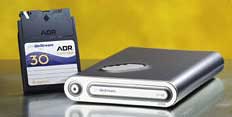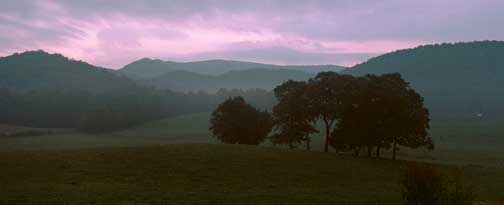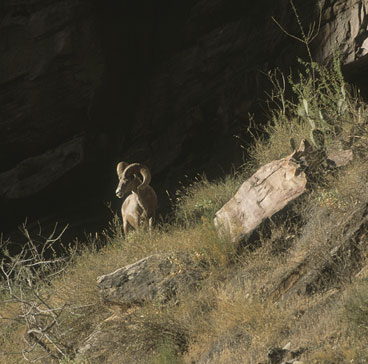The Storage & Archiving
Of Digital Images
This article represents my practice as of the Summer of 2000.
Where to Put Those Megabytes
When I started in computing in the early ’80’s I remember buying a box of ten 5" floppies for about $75 and thinking what a waste this was, because I would never needthat muchstorage. Each disk could hold about100Kof data. How would I ever use up themegabyteof storage that this box represented!?
Well, that was then and this is now. For most of us doing digital image processing a high resolution scan ranges from 25-150 megabytes, depending on the scanner and the film size. SinceAdjustment Layerscan double the size of a file, storage and archiving can become a huge headache not to mention expense. Here then is what I’m doing to store, index and archive my images in as inexpensive and efficient a manner as possible. You may find some of these ideas of use.
Wolf Pen Gap, White County, Georgia. September 2000
Photographed with a Hasselblad XPan and 45mm lens on Provia 100F.
Primary Storage
Curiously, I’ve found that the least expensive storage is a second hard disk. A 50GB drive is only a few hundred dollars, and assuming an average file size of 50MB, a drive like this can hold about 1,000 images. This is adequate for the photographs that I’m likely to need on a regular basis and offers easy access and fast retrieval.
A second drive can easily be installed, simply requiring mounting and attachment to the primary drive’s ribbon cable within the PC’s chassis.
Indexing & Retrieval
There are quite a number of indexing programs, many of them in the $99 range. I don’t use them because I’ve found a simpler and more convenient method.
I organize my photographs into groupings of about 10, roughly what will fit on a CD-ROM, (seeOff-Site Storagebelow). I create a subdirectory on my second hard disk with the name that I’ll give the CD; sayDisk #36. After copying the files to the CD I now usePhotoShop‘sContact Sheetfunction to make a print containing thumbnails of the pictures on the CD and the subdirectory namedDisk #36.
If there are special notes or comments to be made about any of these frames these can easily be hand written on the blank areas of the contact sheet. These prints are then 3-hole punched and stored in a standard 3-ring binder.
I find that it’s fairly easy to find what I want by flipping through the binder — faster than doing so on-screen with a retrieval program, since I never have the time or inclination to do all the key-word indexing that these require to be truly useful.
Big Horn Ram #1,Grand Canyon ‚ May, 2000
Photographed with a Canon EOS-1V and 100~400mm f/5.6L IS lens on Fuji Provia 100F
Off-Site Storage
Back in the early ’80’s I had all of my negatives and prints, which dated back to my earliest days in photography, stored in cardboard boxes. These were in my finished-basement, alongside my darkroom.
At about 2am one night we awoke to the sound of running water coming from the basement. We discovered that a water pipe had burst and all of my negatives and prints had been floating in 3 feet of filthy water for several hours. Almost all were completely ruined.
Since then I have been neurotic about safe storage of my film originals and backups of my digital files. While one can always go back and rescan a safely stored negative or slide the amount of effort that would be lost through the destruction of all copies of my digital files is enormous. I sometimes can spend 5 hours or more working on a file. Multiply that by hundreds of files over several years and you can see why I’m compulsive about backups.
As mentioned above, I organize my photographs into groupings of about 10, roughly what will fit on a CD-ROM. Once I burn the CD the next opportunity I get I take the latest ones and bring them to my place in the country. You can do similarly by asking a friend to store them, or by bringing them to the office. Just so long as they’re in another building.
This way, you will have your original negatives and transparencies, your short-term local disk-based version, and a back-up CD version at another location. No matter what happens, you’ve covered. (If you create an archival tape back-up (see below) then you’ll have an additional version safely stored away as well).
At a typical cost of $1 for a 650MB CD-ROM blank there is no excuse for not making such backups.
Mirrored Lake — CA, 1996
Taken with a Mamiya 645 and 55mm f/2.8 lens on Provia 100.

If you burn a CD-ROM and store it off-site you will have protected yourself against any catastrophic loss of your image files. But, this doesn’t address the problem of bulk storage. Figuring an average of 50MB per photograph a busy photographer’s storage needs can run over 100 Gigabytes (100,000 Megabytes) or more very quickly.
The solution that I use is a tape backup system calledOnStream. I have the30GB USBversion, though it also comes as an internal IDE version as well. (Mac and parallel port versions are also available). I chose theUSBversion because it allows me to also use it with my laptop computer, and thus as a bulk transfer method when moving large volumes of files between my desktop and laptop computers.
The drive costs USD $299 (after $100 rebate) and 30 Gigabyte tapes are about $50 each. This makes the storage cost about the same as with CD-ROM — roughly 10 cents a file; inexpensive indeed.
One of the great appeals of theOnStreamis that though it’s a tape drive it functions as if it were a disk drive, with full drag-and-drop functionality underWindows 98. (In drag and drop mode compression isn’t used and so storage per tape is only 15 Gigabytes). This makes storage and retrieval simple and convenient. It should be noted as well that this drive, which uses high-speedADRtechnology, unlike traditional tape drives is extremely quiet, a bonus for the home digital darkroom.
As for speed, I have never done any serious timing tests. Tape is inherently slow, but since this application is archniving, not a big issue.
Finally, theOnStream 30GBalso comes with comprehensive back-up software that allows for user-initiated or timed backups of your entire hard disk, something that we should all be conscientious about doing regularly.
A Mac Perspective
My friend, Arizona-based landscape photographerAlain Briot, has sent the following comment on how he handles his very large image collection in aMacenvironment.
I use a hard disc for temporary storage of scans and image files. On it I have a folder labeled "Back up". When the contents of this folder reach 650 mb I back it up onto CD ROM. I make two copies of each CD ROM: one stays home while the other goes in my safe deposit box at the bank. The home CD’s are stored in Koskin CD Wallets holding 24 cd’s each. These are kept in a bookcase next to my desk. At this time I have 16 such CD wallets providing storage for 384 cd’s in a very space efficient manner. About half of them are filled and the other half is waiting for new files. I label the spine of each wallet with its specific contents.
To find on which CD ROM a specific image file is located I use a disc cataloging program called Virtual Disc. It is distributed by La Cie and is part of the Silverlining disc utilities package. Virtual disc catalogs each CD as it is ejected from my computer and keeps the catalog onto my hard drive. This virtual catalog is relatively small (about 10 mb for several hundred cd’s) as it only contains aliases of each file together with the original color icon and title of the file. I do not have to do any catalog indexing myself since each file name is kept in the virtual disc catalog.
When I want to find the location of a specific image file I do a search of the virtual disc catalog by typing part of the image file title in the search program. I can also search the contents of each virtual cd by looking at their icons on the screen. Since Photoshop files icons are small versions of the actual photographs this is very easy.
My next computer (Macintosh G4 double processor) will have a DVD-RAM drive which will allow me to store up to 9.4GB of data on one double sided DVD-RAM disc. Because DVD-RAM discs are somewhat expensive ($50 approximately for a 9.4MB disc at this time) I will use this new drive for temporary storage of "in progress" image files as well as for convenient backups of my entire system and application folders. Because I use 3 computers and have complex systems, backing these up is important. At this time I do so on CD ROMs but the size of my system and application folders often exceeds the size of the CD’s making backup complicated and time consuming. The DVD-RAM will bring a new level of convenience.


